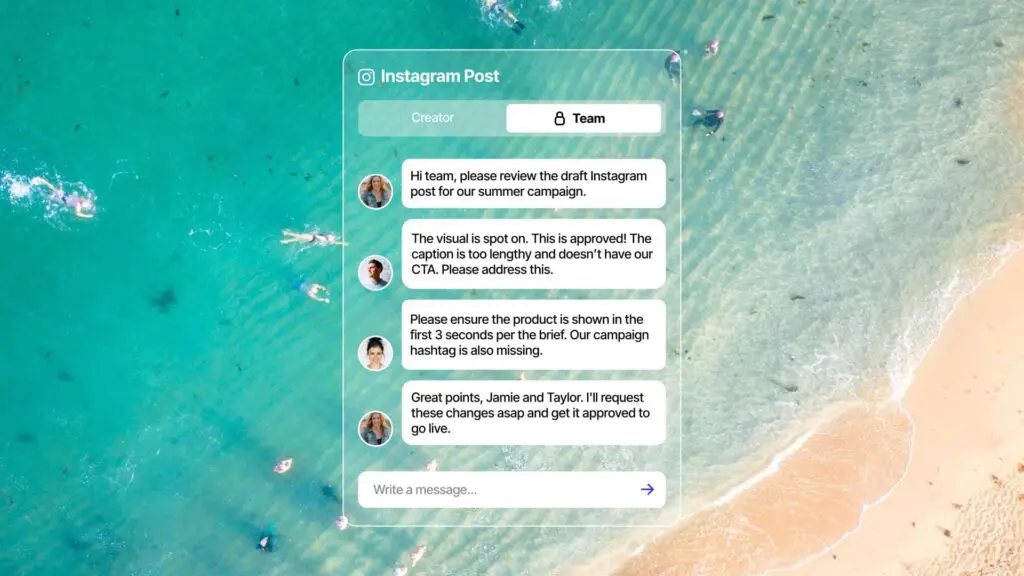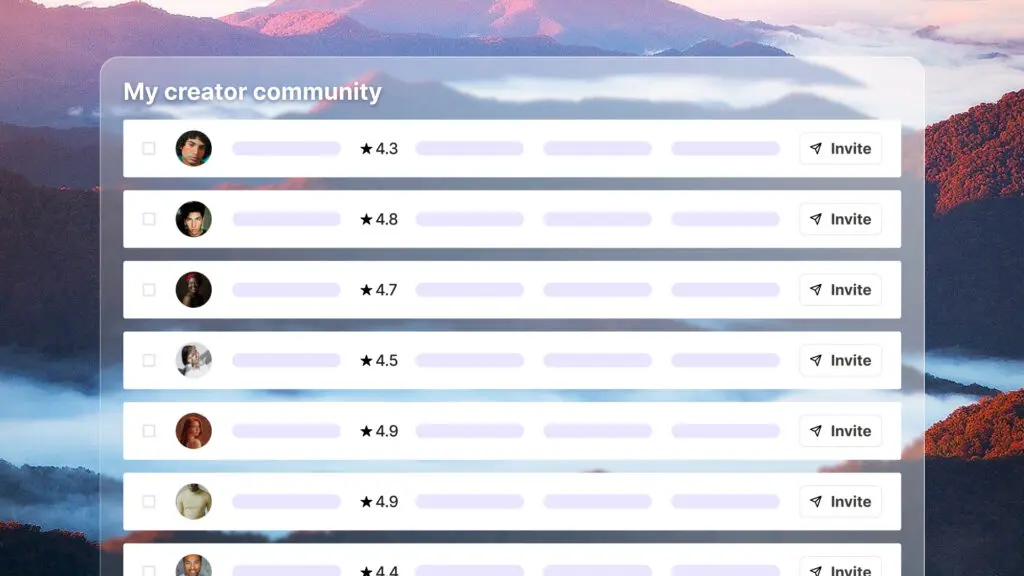

Social media has emerged as an indispensable arena for businesses to connect with their audience and boost their online presence. To excel in this landscape, a comprehensive social media competitor analysis is a valuable tool that no marketer can afford to overlook.
In this guide, we will explore what a social media competitor analysis is, why it is essential, how to conduct one effectively, and, most importantly, how to leverage the insights for success. We’ll also introduce how Vamp, the influencer marketing platform, can simplify and enhance this process by providing real-time data directly from creators’ accounts, giving you a competitive edge.
A social media competitor analysis is a strategic examination of your rivals’ digital marketing efforts, with a primary focus on their social media presence. It delves into their content, engagement strategies, audience demographics, and overall performance on platforms like TikTok, Instagram, Facebook, and YouTube. By scrutinizing your competitors’ activities, you gain valuable insights into what works in your industry, what doesn’t, and how to fine-tune your own social media strategies for maximum impact.
In today’s digital age, where businesses thrive or flounder based on their online presence, understanding what your competitors are doing is not a luxury but a necessity. Social media platforms are a dynamic and ever-changing ecosystem, and keeping up with the latest trends and strategies is paramount for success.

The importance of a social media competitor analysis cannot be overstated. Here are some compelling reasons why it should be a staple in your marketing strategy:
The frequency of your competitor analysis largely depends on the nature of your industry and the pace of change within it. However, as a general guideline, performing a competitor analysis on social media at least once a quarter is advisable. This ensures that you stay updated with the latest trends, monitor your competitors’ moves, and adjust your strategies accordingly.
For industries with rapid changes, such as fashion, technology, or entertainment, more frequent analyses may be required. Conversely, in industries with a slower pace, such as traditional manufacturing, biannual or annual assessments might suffice. The key is to strike a balance between staying informed and not overloading your team with constant monitoring.

To initiate a robust social media competitor analysis, you first need to identify your competitors. Here’s how:
Once you’ve identified your competitors, it’s time to dive deeper into their social media activities.
Here’s a step-by-step guide on how to perform a comprehensive social media competitor analysis:

The real value of a social media competitor analysis lies in how you leverage the insights gained. Here are some practical steps to turn your findings into actionable strategies:
Performing a social media competitor analysis is a data-intensive task, and various tools can simplify the process. Here are some tools you can use:

To streamline your social media competitor analysis process, consider creating a template that you can regularly update. Here’s a basic structure for your template:
By regularly updating this template, you can compare changes over time and make informed decisions accordingly.
Competitor analysis is not a one-time endeavor but an ongoing process. To effectively monitor your competitors on social media, follow these steps:
In conclusion, social media competitor analysis is a powerful tool for businesses looking to excel in the ever-evolving world of digital marketing. By gaining insights into your competitors’ strategies and leveraging data-driven decision-making, you can stay ahead of the competition and find new opportunities to engage with your audience effectively.
Remember that Vamp, as an official partner of TikTok, Meta (Instagram and Facebook), and YouTube, offers real-time data directly from creators’ accounts, making it easier for marketers to monitor, report, and achieve success in their campaigns. Don’t underestimate the power of a well-executed social media competitor analysis in enhancing your social media presence and ultimately growing your business.



| Cookie | Duration | Description |
|---|---|---|
| __cf_bm | 30 minutes | This cookie, set by Cloudflare, is used to support Cloudflare Bot Management. |
| _abck | 1 year | This cookie is used to detect and defend when a client attempt to replay a cookie.This cookie manages the interaction with online bots and takes the appropriate actions. |
| _GRECAPTCHA | 5 months 27 days | This cookie is set by the Google recaptcha service to identify bots to protect the website against malicious spam attacks. |
| bm_sz | 4 hours | This cookie is set by the provider Akamai Bot Manager. This cookie is used to manage the interaction with the online bots. It also helps in fraud preventions |
| cookielawinfo-checkbox-advertisement | 1 year | Set by the GDPR Cookie Consent plugin, this cookie is used to record the user consent for the cookies in the "Advertisement" category . |
| cookielawinfo-checkbox-analytics | 11 months | This cookie is set by GDPR Cookie Consent plugin. The cookie is used to store the user consent for the cookies in the category "Analytics". |
| cookielawinfo-checkbox-functional | 11 months | The cookie is set by GDPR cookie consent to record the user consent for the cookies in the category "Functional". |
| cookielawinfo-checkbox-necessary | 11 months | This cookie is set by GDPR Cookie Consent plugin. The cookies is used to store the user consent for the cookies in the category "Necessary". |
| cookielawinfo-checkbox-others | 11 months | This cookie is set by GDPR Cookie Consent plugin. The cookie is used to store the user consent for the cookies in the category "Other. |
| cookielawinfo-checkbox-performance | 11 months | This cookie is set by GDPR Cookie Consent plugin. The cookie is used to store the user consent for the cookies in the category "Performance". |
| CookieLawInfoConsent | 1 year | Records the default button state of the corresponding category & the status of CCPA. It works only in coordination with the primary cookie. |
| csrftoken | past | This cookie is associated with Django web development platform for python. Used to help protect the website against Cross-Site Request Forgery attacks |
| elementor | never | This cookie is used by the website's WordPress theme. It allows the website owner to implement or change the website's content in real-time. |
| viewed_cookie_policy | 11 months | The cookie is set by the GDPR Cookie Consent plugin and is used to store whether or not user has consented to the use of cookies. It does not store any personal data. |
| Cookie | Duration | Description |
|---|---|---|
| __hssc | 30 minutes | HubSpot sets this cookie to keep track of sessions and to determine if HubSpot should increment the session number and timestamps in the __hstc cookie. |
| __hssrc | session | This cookie is set by Hubspot whenever it changes the session cookie. The __hssrc cookie set to 1 indicates that the user has restarted the browser, and if the cookie does not exist, it is assumed to be a new session. |
| __hstc | 5 months 27 days | This is the main cookie set by Hubspot, for tracking visitors. It contains the domain, initial timestamp (first visit), last timestamp (last visit), current timestamp (this visit), and session number (increments for each subsequent session). |
| _ga | 2 years | The _ga cookie, installed by Google Analytics, calculates visitor, session and campaign data and also keeps track of site usage for the site's analytics report. The cookie stores information anonymously and assigns a randomly generated number to recognize unique visitors. |
| _ga_56JWQ0019V | 2 years | This cookie is installed by Google Analytics. |
| _gat_UA-132076027-1 | 1 minute | A variation of the _gat cookie set by Google Analytics and Google Tag Manager to allow website owners to track visitor behaviour and measure site performance. The pattern element in the name contains the unique identity number of the account or website it relates to. |
| _gcl_au | 3 months | Provided by Google Tag Manager to experiment advertisement efficiency of websites using their services. |
| _gid | 1 day | Installed by Google Analytics, _gid cookie stores information on how visitors use a website, while also creating an analytics report of the website's performance. Some of the data that are collected include the number of visitors, their source, and the pages they visit anonymously. |
| bscookie | 1 year | LinkedIn sets this cookie to store performed actions on the website. |
| CONSENT | 2 years | YouTube sets this cookie via embedded youtube-videos and registers anonymous statistical data. |
| hubspotutk | 5 months 27 days | HubSpot sets this cookie to keep track of the visitors to the website. This cookie is passed to HubSpot on form submission and used when deduplicating contacts. |
| Cookie | Duration | Description |
|---|---|---|
| _fbp | 3 months | This cookie is set by Facebook to display advertisements when either on Facebook or on a digital platform powered by Facebook advertising, after visiting the website. |
| _pin_unauth | 1 year | This cookie is placed by Pinterest Tag when the user cannot be matched. It contains a unique UUID to group actions across pages. |
| AnalyticsSyncHistory | 1 month | No description |
| bcookie | 1 year | LinkedIn sets this cookie from LinkedIn share buttons and ad tags to recognize browser ID. |
| bscookie | 1 year | LinkedIn sets this cookie to store performed actions on the website. |
| fr | 3 months | Facebook sets this cookie to show relevant advertisements to users by tracking user behaviour across the web, on sites that have Facebook pixel or Facebook social plugin. |
| IDE | 1 year 24 days | Google DoubleClick IDE cookies are used to store information about how the user uses the website to present them with relevant ads and according to the user profile. |
| lang | session | LinkedIn sets this cookie to remember a user's language setting. |
| lidc | 1 day | LinkedIn sets the lidc cookie to facilitate data center selection. |
| MONITOR_WEB_ID | 3 months | The cookie is used by: TikTok The functionality is: to store if the user has seen embedded content. The purpose is: Marketing/Tracking |
| test_cookie | 15 minutes | The test_cookie is set by doubleclick.net and is used to determine if the user's browser supports cookies. |
| ttwid | 1 year | No description available. |
| UserMatchHistory | 1 month | LinkedIn sets this cookie for LinkedIn Ads ID syncing. |
| VISITOR_INFO1_LIVE | 5 months 27 days | A cookie set by YouTube to measure bandwidth that determines whether the user gets the new or old player interface. |
| YSC | session | YSC cookie is set by Youtube and is used to track the views of embedded videos on Youtube pages. |
| yt-remote-connected-devices | never | YouTube sets this cookie to store the video preferences of the user using embedded YouTube video. |
| yt-remote-device-id | never | YouTube sets this cookie to store the video preferences of the user using embedded YouTube video. |
| yt.innertube::nextId | never | This cookie, set by YouTube, registers a unique ID to store data on what videos from YouTube the user has seen. |
| yt.innertube::requests | never | This cookie, set by YouTube, registers a unique ID to store data on what videos from YouTube the user has seen. |
| Cookie | Duration | Description |
|---|---|---|
| li_gc | 5 months 27 days | No description |
| ln_or | 1 day | No description |
| msToken | 10 days | No description |
| wp-wpml_current_language | session | No description available. |